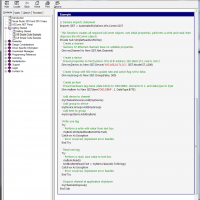Search the Community
Showing results for tags 'Siemens s7-1200'.
Found 209 results
-
Dear all, I have implemented PID temperature control for mini heating tank system using Siemens S7-313-c2-DP PLC. Now, I want to plot the values of the "process value (temperature) " and "Setpoint" as a function of time in wincc flexible runtime. I am using wincc flexible 2008 advance SP3. However, the problem is that I have tried plotting the value of "process value" as a function of time using trendview, But the change in the value is not smooth i.e. it is in step manner. Besides, the value of temperature progresses towards the left side of the graph, but I want it in the right side. And also I would like to plot two values against time in one graph in smooth transition so that I can make the comparison and I want the plotting only on the right side of graph. So, how to do all these things? Since, I am a newbie to WinCC, I would appreciate your help. Thank you. Regards, Ankur Gajjar
-
- HMI
- Wincc Flexible 2008
-
(and 2 more)
Tagged with:
-
I have a Simatic S7-1200 and i have a couple of questions :) I have three analog sensor giving information to the plc. software = Simatic step 7 basic V11 my questions: - can i connect the plc via a cable to a rooter to access the network to use a printer ? -can i connect a SIMATIC HMI KTP400 BASIC COLOR PN via a cable to a rooter to use with the plc via the network? - can i generate a document in the software , add my sensor data and print the document using all of the above ? thanks for all the help :)
-
Hi there, I have trouble understanding the "mechanics" of STL programming language for Siemens S7-300 PLC. For instance I have a code which looks like this (taken from the Siemens manual for extended pulse timer): With regards to the first line, AND operator checks whether the state of I 2.0 is '1'. According to the "Bit Logic Instructions" manual, it also ANDs the test result with RLO. Now the question is - what RLO is it if there are no operations beforehand? What memory area does it use for that particular RLO? Moreover, what is the Boolean bit logic string in this case? I presume it is all the lines up to the '=' sign. The confusion is also caused by instructions (FR, L, T) which are not logical operations or RLO, although there is associated memory bit with them. I'd be grateful if you could clarify this matter? Many thanks!
-
Hello, I am working on a Siemens S7-300 PLC with a WinCC HMI and I am looking to perform logging of certain values every 12 or 24 hours. Basically I have a Flow meter that constantly has flow through it. Right now I have the PLC set up to record the current value of the flow, as well as a totalizer to indicate how much flow has gone through the valve. (until an operator chooses to reset it) I need to create some sort of logic or utilize something in WinCC to calculate the flow through the valve only for that day. After that day, the value will be either deleted or replaced with a new value the next day... If anyone has any tips or advice it would be greatly appreciated. Thank you,
-
Hello everyone, I am a freshman, studying about PLC. I work with S7-400 system. Please help me how to read digital input signal directly from humidity sensor using PLC. Thank you so much. Best regard!
-

communication between keithley controller 2182A & any siemens plc
knowledge greedy posted a topic in Siemens
can anyone please provide me how to communicate between keithley controller 2182A(nano voltmeter) and any siemens plc.aslo the programme & instruction & parameters..ASAP using RS-232 interface?-
- rs-232
- keithley controller 2182A
-
(and 1 more)
Tagged with:
-
Hi I am having a problem with an error/fault code. The fault comes from a lenze drive as an integer. We have a proface HMI monitoring a DBW in the siemens S7 300 that holds the lenze fault code. The PLC comes up with a generic code "lenze drive fault". The proface comes up with the drive code. I would like the PLC to produce a fault description using the lenze fault code in the DBW, instead of the generic one [listed above]. could anyone please help with this problem Thanks Robbo
-

Siemens S7 Ethernet Driver for .NET Framework (2.0 - 4.8)
Automated Solutions posted a file in Demo Software
Version 3.11.5.0
3821 downloads
.NET class library for use in Visual Studio.NET to create HMI/SCADA apps that communicate with Siemens S7-200, S7-300, S7-400, S7-1200, & S7-1500 PLCs via Ethernet. For .NET Framework 2.0 - 4.8 projects. Supports UDTs Does not require OPC, Siemens, or 3rd party drivers x86, x64, and Any CPU compatible Visual Studio.NET 2010, 2012, 2013, 2015, 2017, 2019, and 2022 compatible Most .NET targets are supported, including Web, Windows, console, and service apps Can be configured programmatically or visually Visually design your entire communications configuration without writing a single line of code Extremely high performance - 5~10 mSec typical transaction time Highly optimized to minimize communications transactions Tag database can be configured via code or visual designer Abstract base classes allow you to write generic code that works with all drivers Synchronous and asynchronous read/write methods Data change notifications Provides common user interface across all driver classes including A-B, GE, Modbus, etc. No limit on number of devices or data points Multi-threaded for high data throughput Includes extensive help system Example applications with VB and C# source code included. Easily connect to your factory floor systems. Immediate Internet delivery and online license activation. No runtime fees or keys for qualified applications -

[Demo Software] - Siemens S7 Ethernet Driver for .NET Framework (2.0 - 4.8)
Automated Solutions posted a topic in Download Comments
File Name: Siemens S7 Ethernet Driver for .NET File Submitter: Automated Solutions File Submitted: 21 Apr 2013 File Category: Demo Software .NET Component for use in Visual Studio.NET to create HMI/SCADA apps that communicate with Siemens S7-200, S7-300, S7-400, S7-1200, & S7-1500 PLCs via Ethernet. Supports UDTs Does not require OPC, Siemens, or 3rd party drivers x86, x64, and Any CPU compatible Visual Studio.NET 2005, 2008, 2010, 2012, and 2013 Compatible Most .NET targets are supported, including Web, Windows, console, and service apps. Can be configured programmatically or visually Visually design your entire communications configuration without writing a single line of code Extremely high performance - 5~10 mSec typical transaction time Highly optimized to minimize communications transactions Tag database can be configured via code or visual designer Abstract base classes allow you to write generic code that works with all drivers Synchronous and asynchronous read/write methods Data change notifications Provides common user interface across all driver classes including A-B, GE, Modbus, etc. No limit on number of devices or data points Multi-threaded for high data throughput Includes extensive help system Example applications with VB and C# source code included. Easily connect to your factory floor systems. Immediate Internet delivery and online license activation. No runtime fees or keys for qualified applications Click here to download this file


